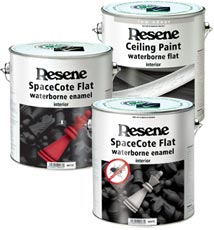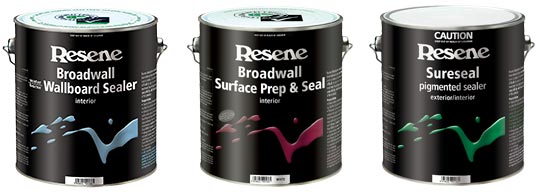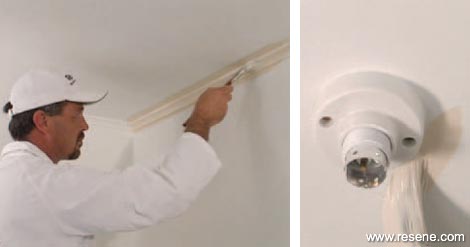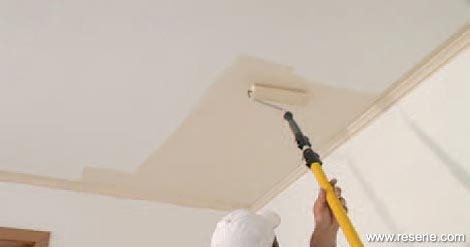Resene DIY project #7
How to paint like a professional - training videos and project sheets
Ceilings are typically painted using flat or very low sheen paints to minimise unpleasant, critical light problems. Resene have a number of products recommended for this including:

Resene SpaceCote Flat (see Data Sheet D314) a washable waterborne enamel wall and ceiling paint (also available in a fly repellent option) and Resene Ceiling Paint (see Data Sheet D305). The application techniques are similar for each product.
Cleaning and preparation:
If painting a new ceiling ensure it is clean and dust free and has been sealed with either Resene Broadwall Waterborne Wallboard Sealer (see Data Sheet D403), Resene Broadwall Surface Prep & Seal (see Data Sheet D807) or Resene Sureseal (see Data Sheet D42), which we recommend for bathrooms and wet areas.
If the ceiling has been previously painted, use a clean cloth and wipe the ceiling down using a solution of Resene Interior Paintwork Cleaner and clean water paying particular attention to any fly dirt.

Fill any gaps and cracks before sanding smooth the filled areas and spot priming.
Seal nicotine, water and smoke stains with Resene Sureseal to prevent discolouring the fresh ceiling paint.
Use the PAL No. 1 roller sleeve. It is a good idea to first lightly dampen the roller sleeve with fresh water ensuring excess water is removed. It should be slightly damp rather than wet to touch.
You will also need a good quality extension pole and brush – we recommend the use of the 50mm Legend cutting-in brush.
Protect flooring and furniture with drop sheets, It is a good idea to mask light fittings, etc to prevent any paint splatter.
It is important to paint the ceiling in one go, ensuring the paint’s wet edge is maintained. It is best practice to paint ceiling areas before walls and joinery
– it is easier to cut into the top of the wall than the edge of the scotia so bringing the ceiling paint over the edge of the scotia on to the wall makes sense.
In order to avoid unsightly roller tracking it is important to maintain the paint’s ‘wet edge’ by working across the shortest distance of the ceiling and completing each coat in a single application without stopping.
In order to reduce surface imperfections work across the shortest distance of the ceiling and away from critical light sources such as large windows and skylights.
Painting the ceiling with Resene SpaceCote Flat:

Pour approximately 1 to 1½ litres of paint into the roller tray. Now add about half a litre of paint to a paint pot. Use the brush to wipe the edge removing the excess paint. Replace the can’s lid to prevent spillage and the paint skinning and set to one side.
Work the roller well into the paint – with new roller sleeves this usually takes a couple of minutes.
Hold the paint brush as you would a pen the further down the handle the better control you have.

By wiping the brush’s leading edge on the edge of the paint pot you will cut in more precisely.
Using the PAL 50mm Legend cutting-in brush, paint the edges and around light fittings etc.

There is no ideal direction to follow when cutting-in, however generally right handed people prefer to follow a left to right direction while left handed people a right to left direction.
Aim to complete approx 40-50cm each time – laying off the paint as you progress. Start each area about 15cm from the edge and work the paint back to the just completed area before continuing along the scotia. This ensures an equal amount of paint is applied.

Attach the extension handle and work the roller into paint – the better quality aluminium handles are easier to use and do not flex like a wooden handle.

Begin in the corner closest to any critical light sources.
Lay the roller onto the ceiling back from the corner and out from the edge and roll back towards the corner distributing the paint across the ceiling and getting as close as practicable to the edges.

Aim to complete approx 1m2 for each roller load (based on using a 230mm PAL No.1 roller sleeve).

Unlike wall areas ceilings are typically layed-off as the painter progresses. Lay-off each completed section into the previous section.
Progress along the wall, taking care to lay-off in the same direction.
When approaching the edges and sides of the ceiling manipulate the roller to get as close as possible. This helps ensure a consistent roller texture on the ceiling, helping to eliminate patchiness and picture framing (the finish difference between brushed and rolled areas).

Once the full width is complete return to the starting edge and repeat the process laying-off as you go, alongside and slightly over the previously completed section.

Once the ceiling is complete allow two to four hours to dry and apply a second coat repeating the process.
Ensure the room has good ventilation and warmth to ensure the paint cures well.
If access to the ceiling is straightforward and little preparation is needed then painting ceilings, wall areas and most other surfaces is simple and easy.
Please take the time to carefully read through the instructions on the label. More information including Data Sheets for the Resene products mentioned and Safety Data Sheet/s (SDS) can be found on the Resene website.
A PAL No.1 roller sleeve. The roller has been tested and matched to Resene Ceiling Paint. Note: Resene have this roller sleeve custom packed for our stores.
A brush. We recommend the 50mm Legend cutting-in brush.
A roller tray and roller handle.
220 grit zinc sterate sandpaper to sand any imperfections before applying the topcoat.
A gap filler such as PAL Contract Series Filler or Selleys No More Gaps to fill any gaps between the ceiling and scotia.
An extension pole. We recommend investing in a quality extension pole such as the PAL Extension Pole Metal Masterflow, especially if future painting projects are planned. The pole also accommodates most base plates for pole sanders.
A decent drop sheet(s), especially if other painting projects are planned.
A putty knife or similar for applying any filler.
Painter’s gloves – they are relatively inexpensive and save a lot of cleaning.
Masking tape to protect light switches fittings, etc.
A hand sander or pole sander.
› Download this project sheet as a PDF
Training Videos and Project Sheets
Learn how to prepare surfaces and apply paint to get the best from your paint finish with these handy videos and project sheets.